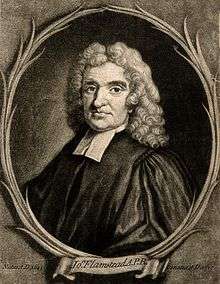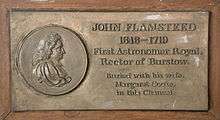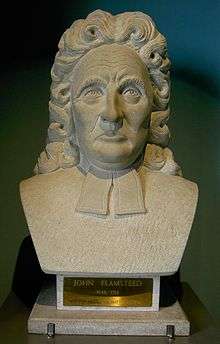John Flamsteed
| John Flamsteed | |
|---|---|
 John Flamsteed by Godfrey Kneller, 1702 | |
| Born |
19 August 1646 Denby, Derbyshire, England |
| Died |
31 December 1719 (aged 73) Burstow, Surrey, England |
| Nationality | English |
| Fields | Astronomy |
| Alma mater | Jesus College, Cambridge |
| Known for | First Astronomer Royal |
| Influenced |
Joseph Crosthwait Abraham Sharp |
| Spouse | Margaret |
John Flamsteed FRS (19 August 1646 – 31 December 1719) was an English astronomer and the first Astronomer Royal. He catalogued over 3000 stars.[1]
Life
Flamsteed was born in Denby, Derbyshire, England, the only son of Stephen Flamsteed and his first wife, Mary Spadman. He was educated at the free school of Derby, and was educated at Derby School, in St Peter's Churchyard, Derby, near where his father carried on a malting business. At that time, most masters of the school were Puritans. Flamsteed had a solid knowledge of Latin, essential for reading the literature of the day, and a love of history, leaving the school in May, 1662.[2]:3–4
His progress to Jesus College, Cambridge, recommended by the Master of Derby School, was delayed by some years of chronic ill health. During those years, Flamsteed gave his father some help in his business, and from his father learnt arithmetic and the use of fractions, developing a keen interest in mathematics and astronomy. In July 1662, he was fascinated by the thirteenth century work of Johannes de Sacrobosco, De sphaera mundi, and on 12 September 1662 observed his first partial solar eclipse. Early in 1663, he read Thomas Fale's The Art of Dialling, which set off an interest in sundials. In the summer of 1663, he read Wingate's Canon, William Oughtred's Canon, and Thomas Stirrup's Art of Dialling. At about the same time, he acquired Thomas Street's Astronomia Carolina, or A New Theory of the Celestial Motions (Caroline Tables). He associated himself with local gentlemen interested in astronomy, including William Litchford, whose library included the work of the astrologer John Gadbury which included astronomical tables by Jeremiah Horrocks, who had died in 1641 at the age of twenty-two. Flamsteed was greatly impressed (as Isaac Newton had been) by the work of Horrocks.[2]:8–11
In August 1665, at the age of nineteen and as a gift for his friend Litchford, Flamsteed wrote his first paper on astronomy, entitled Mathematical Essays, concerning the design, use and construction of an astronomer's quadrant, including tables for the latitude of Derby.[2]:11
In September 1670, Flamsteed visited Cambridge and entered his name as an undergraduate at Jesus College.[3] While it seems he never took up full residence, he was there for two months in 1674, and had the opportunity to hear Isaac Newton's Lucasian Lectures.[2]:26
Ordained a deacon, he was preparing to take up a living in Derbyshire when he was invited to London by his patron Jonas Moore, Surveyor-General of the Ordnance. Moore had recently made an offer to the Royal Society to pay for the establishment of an observatory. These plans were, however, preempted when Charles II was persuaded by his mistress, Louise de Kérouaille, Duchess of Portsmouth, to hear about a proposal to find longitude by the position of the Moon from an individual known as Le Sieur de St. Pierre. Charles appointed a Royal Commission to examine the proposal in December 1674, consisting of Lord Brouncker, Seth Ward, Samuel Moreland, Christopher Wren, Silius Titus, John Pell and Robert Hooke.
Having arrived in London on 2 February 1675, and staying with Jonas Moore at the Tower of London, Flamsteed had the opportunity to be taken by Titus to meet the King. He was subsequently admitted as an official Assistant to the Royal Commission and supplied observations in order to test St Pierre's proposal and to offer his own comments. The Commission's conclusions were that, although St Pierre's proposal was not worth further consideration, the King should consider establishing an observatory and appointing an observer in order to better map the stars and the motions of the Moon in order to underpin the successful development of the lunar-distance method of finding longitude.[4]
On 4 March 1675 Flamsteed was appointed by royal warrant "The King's Astronomical Observator" — the first English Astronomer Royal, with an allowance of £100 a year. The warrant stated his task as "rectifieing the Tables of the motions of the Heavens, and the places of the fixed stars, so as to find out the so much desired Longitude of places for Perfecteing the Art of Navigation".[5] In June 1675, another royal warrant provided for the founding of the Royal Greenwich Observatory, and Flamsteed laid the foundation stone on 10 August.[6]
In February 1676, he was admitted a Fellow of the Royal Society, and in July, he moved into the Observatory where he lived until 1684, when he was finally appointed priest to the parish of Burstow, Surrey. He held that office, as well as that of Astronomer Royal, until his death. He is buried at Burstow, and the east window in the church was dedicated to him as a memorial.[7]

The will of Flamsteed’s widow, Margaret, left instructions for her own remains to be deposited “in the same Grave in which Mr John Flamsteed is buryed in the Chancell of Burstow Church.” Intriguingly, she also left instructions, and twenty five pounds, for the executor of her will to place “in the aforesaid Chancell of Burstow… A Marble stone or Monument, with an inscription in Latin, in memory of the late Reverend Mr. John Flamsteed.” It seems no such monument was created, and almost 200 years later, a plaque was placed to mark his burial in the Chancel.[8]
After his death, his papers and scientific instruments were taken by his widow. The papers were returned many years later, but the instruments disappeared.[9]
Scientific work

Flamsteed accurately calculated the solar eclipses of 1666 and 1668. He was responsible for several of the earliest recorded sightings of the planet Uranus, which he mistook for a star and catalogued as '34 Tauri'. The first of these was in December 1690, which remains the earliest known sighting of Uranus by an astronomer.
On 16 August 1680 Flamsteed catalogued a star, 3 Cassiopeiae, that later astronomers were unable to corroborate. Three hundred years later, the American astronomical historian William Ashworth suggested that what Flamsteed may have seen was the most recent supernova in the galaxy's history, an event which would leave as its remnant the strongest radio source outside of the solar system, known in the third Cambridge (3C) catalogue as 3C 461 and commonly called Cassiopeia A by astronomers. Because the position of "3 Cassiopeiae" does not precisely match that of Cassiopeia A, and because the expansion wave associated with the explosion has been worked backward to the year 1667 and not 1680, some historians feel that all Flamsteed may have done was incorrectly note the position of a star already known.[10]
In 1681 Flamsteed proposed that the two great comets observed in November and December 1680 were not separate bodies, but rather a single comet travelling first towards the Sun and then away from it. Although Isaac Newton first disagreed with Flamsteed, he later came to agree with him and theorized that comets, like planets, moved around the sun in large, closed elliptical orbits. An angry Flamsteed later learned that Newton had gained access to Flamsteed's observations and data, with the aid of Edmund Halley.[11]
As Astronomer Royal, Flamsteed spent some forty years observing and making meticulous records for his star catalogue, which would eventually triple the number of entries in Tycho Brahe's sky atlas. Unwilling to risk his reputation by releasing unverified data, he kept the incomplete records under seal at Greenwich. In 1712, Isaac Newton, then President of the Royal Society, and Edmund Halley again obtained Flamsteed's data and published a pirated star catalogue.[11] Flamsteed managed to gather three hundred of the four hundred printings and burned them. "If Sir I.N. would be sensible of it, I have done both him and Dr. Halley a great kindness," he wrote to his assistant Abraham Sharp.[12]
In 1725 Flamsteed's own version of Historia Coelestis Britannica was published posthumously, edited by his wife, Margaret. This contained Flamsteed's observations, and included a catalogue of 2,935 stars to much greater accuracy than any prior work. It was considered the first significant contribution of the Greenwich Observatory, and the numerical Flamsteed designations for stars that were added subsequently to a French edition are still in use.[13] In 1729 his wife published his Atlas Coelestis, assisted by Joseph Crosthwait and Abraham Sharp, who were responsible for the technical side.
Honours
- Fellow of the Royal Society (1677)
- The Flamsteed Astronomy Society is named in honour of the first Astronomer Royal and is based befittingly at The Royal Observatory Greenwich.
- The crater Flamsteed on the Moon is named after him.
- The asteroid (4987) Flamsteed is named in his honour.
- Numerous schools and colleges in Derbyshire have been named after him. The science block at John Port School is named Flamsteed in recognition of his work for science. John Flamsteed Community School in Denby carries his name. Flamsteed House at the Ecclesbourne School in Duffield is also named after him.
- In early 2013 Derby City Council and Derby Civic Society announced they would erect a Blue Plaque in his honour at the Queen Street former Clock Works in Derby.)[14] (This has since been erected and also honours Joseph Wright of Derby who lived in the house formerly owned by Flamsteed.)
See also
- Flamsteed objects
- 3 Cassiopeiae (possibly a supernova sighting or recording error)
References
- ↑ Chambers, Robert (1864) Chambers Book of Days
- 1 2 3 4 Birks, John L. (1999) John Flamsteed, the first Astronomer Royal. London, Avon Books. ISBN 0-7503-0147-3
- ↑ "Flamsteed, John (FLMT670J)". A Cambridge Alumni Database. University of Cambridge.
- ↑ Howse, Derek (1997). Greenwich Time and the Longitude. Philip Wilson. ISBN 0856674680.
- ↑ Willmoth, Frances, ed. (1997). Flamsteed's Stars: New Perspectives on the Life and Work of the First Astronomer Royal, 1646-1719. The Boydell Press. p. 60. ISBN 0851157068.
- ↑ Howse, Derek (1997). Greenwich Time and Longitude. Philip Wilson. pp. 44–45. ISBN 0856674680.
- ↑ Malden, H. E. (ed) (1911). "A History of the County of Surrey: Volume 3. Parishes: Burstow". Victoria County History of Surrey. British History Online. pp. 176–182. Retrieved 14 June 2013.
- ↑ http://blogs.greenwich.co.uk/rob-powell/the-grave-of-john-flamsteed/
- ↑ Hirschfeld, Alan W. (2001). Parallax: The Race to Measure the Cosmos. Henry Holt and Co. p. 162. ISBN 0716737116.
- ↑ Ashworth, William (1980). "A Probable Flamsteed Observation of the Cassiopeia-A Supernova". Journal for the History of Astronomy. 11: 1. Bibcode:1980JHA....11....1A. Retrieved 15 April 2015 – via The SAO/NASA Astrophysics Data System.
- 1 2 Jardine, Lisa (15 March 2013). "A Point of View: Crowd-sourcing comets". Magazine. BBC News. Retrieved 20 May 2013.
- ↑ Sobel, Dava (1995). Longitude: The True Story of a Lone Genius Who Solved the Greatest Scientific Problem of His Time. New York: Walker & Company. ISBN 978-0-8027-1529-6.
- ↑ Ridpath, Ian. "Flamsteed numbers – where they really came from". Retrieved 8 January 2012.
- ↑ "List Of Derbeians To Be Honoured". Derby Evening Telegraph, 12 February 2013
Further reading
- The correspondence of John Flamsteed, the first Astronomer Royal compiled and edited by Eric G. Forbes, ... Lesley Murdin and Frances Willmoth. Bristol: Institute of Physics Publishing, 1995-2002 ISBN 0-7503-0147-3 (v. 1); ISBN 0-7503-0391-3 (v. 2) ; ISBN 0-7503-0763-3 (v.3)
- The Gresham lectures of John Flamsteed, edited and introduced by Eric G. Forbes. London: Mansell, 1975 ISBN 0-7201-0518-8
- Newton's Tyranny: The Suppressed Scientific Discoveries of Stephen Gray and John Flamsteed, David H. Clark & Stephen H.P. Clark. W. H. Freeman, 2001 ISBN 0-7167-4701-4
External links
| Wikimedia Commons has media related to John Flamsteed. |
| Wikisource has the text of the 1911 Encyclopædia Britannica article Flamsteed, John. |
- Online catalogue of Flamsteed's working and personal papers (part of the Royal Greenwich Observatory Archives held at Cambridge University Library)
- John Flamsteed Biography (SEDS)
- Rare book collection at the Vienna Institute of Astronomy
- Flamsteed biography
- Atlas Coelestis, 1729 edition - Full digital facsimile, Linda Hall Library.
- Atlas Céleste de Flamstéed , 1776 French edition reproduced by J. Fortin - Full digital facsimile, Linda Hall Library.
- Flamsteed Astronomy Society
- Atlas coelestis, Londra Edizione del 1753 da www.atlascoelestis.com
- Atlas coelestis, Londra Edizione del 1753 colorata a mano da www.atlascoelestis.com